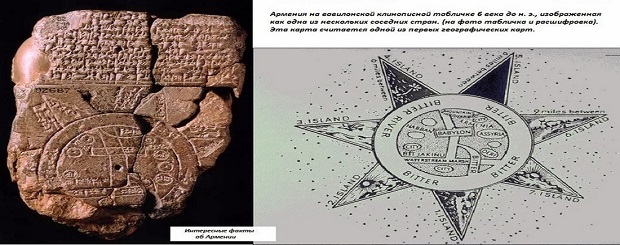
Armenia’s Ancient Geographical Names – Art-A-Tsolum
May 4, 2018 Antiquities, History //Art-A-Tsolum – PREVIOUS ARTICLE://
Although ancient Mesopotamian civilizations all fell or lost their significance at different points in time, their influence exists to this day. Cartography has been just one among the many crafts that have been developed and spread between the banks of the Tigris and Euphrates Rivers thousands of years ago.
One of the oldest maps of the world (that includes only the lands known at the time, the Near and Middle East) was carved out on a clay tablet. This map is considered to have been made in Babylon in the 6th century BC. This map includes the land called Urartu/Urashtu (the Kingdom of Van), which are the Assyrian/Babylonian names of the Kingdom of Van. Ancient Persians named this land Armina. Over the following centuries, this country would become known as Armenia.
The Kingdom of Van existed between the 9th and 6th centuries BC. Over this time period, the kingdom withstood the pressure of Assyria, Babylon, Persia, and Media. The state was located around Mount Ararat, a millennia-old sacred symbol of the Armenians. Before being moved to Tushpa (Armenian transliteration: Tosp), the capital of the kingdom was the city of Arzashkun, the oldest Armenian capital.
Tushpa’s fortress still rises above the city of Van, another ancient Armenian city that is now located in Eastern Turkey (Western Armenia). Prior to the 1915 Armenian Genocide, the city has been the oldest Armenian-populated city in the world. Apart from that, Van is one of the oldest cities that has been continuously inhabited over the last millennia.
Yerevan, the present-day capital of Armenia, was also established in the times of the Kingdom of Van. Its oldest structure, the Erebuni Fortress, was built by King Argishti I in 782 BC. The inscription of the king found on one of the fortress’ walls is pretty much the “birth certificate” of Yerevan, which’s name, by the way, derives from “Erebuni.” The 2,750-year anniversary was met with great celebrations in 1968. Nowadays, the anniversary of the city is celebrated every year in October and is accompanied by a variety of social events.
Sources:
1. Kurt Buzard. “Babylonian World Map, British Museum, London”, Travel to Eat, October 9, 2012
2. Rouben Galichian. Historic Maps of Armenia: The Cartographic Heritage. I. B. Tauris, 2004
4. Jona Lendering. “Urartu”, Livius.Org, October 12, 2011
5. Wikipedia: “Babylonian Map of the World”

allinnet.info/antiquities/armenias-ancient-geographical-names/
